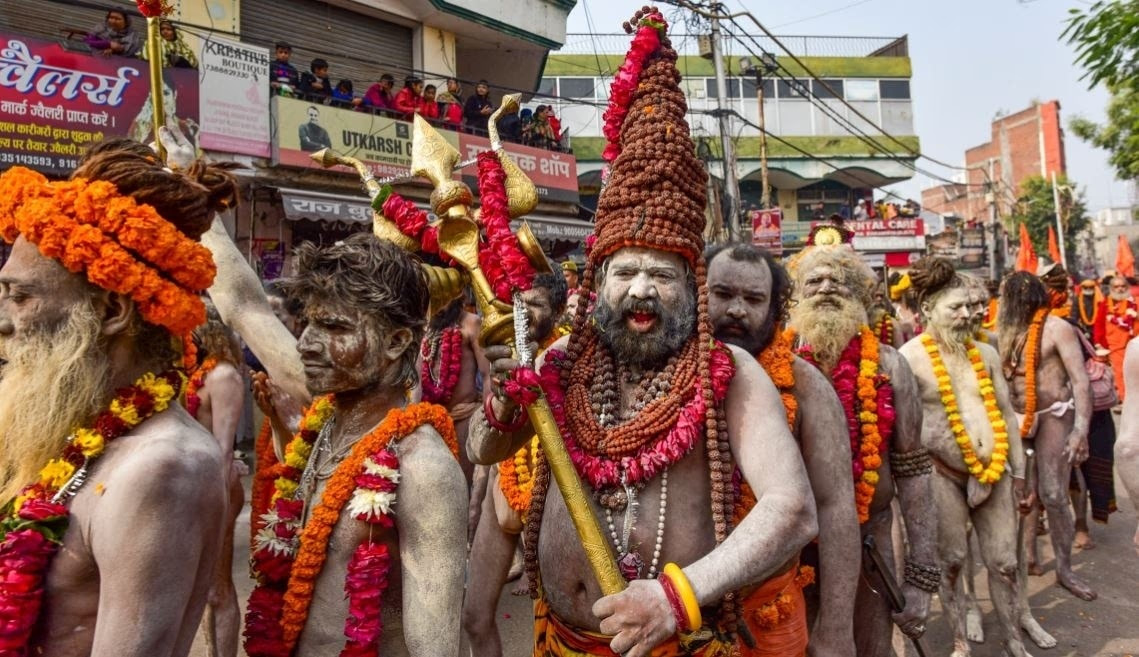The magnificent spiritual gathering known as the Maha Kumbh Mela, held every 12 years in India, draws millions of devotees from around the globe. Amidst this sea of faith, the enigmatic Naga Sadhus stand out, captivating attention with their unique appearance and customs.
Naga Sadhus are members of various akharas or monastic sects, dedicating their lives to spiritual enlightenment by renouncing all worldly pleasures. Their distinct appearance is recognized by their naked, often ash-covered bodies, symbolizing their renunciation of worldly possessions and desires.
History
India's history is enriched with diverse religious and cultural traditions, particularly sects emerging from Shaivism, one of Hinduism's oldest forms venerating Lord Shiva as the supreme deity. Among these sects, Naga Sadhus are noteworthy for their ancient origins and profound influence on Indian spiritual practices.
When Alexander the Great invaded India around 326 BCE, he encountered various religious sects. Historical evidence and some historians suggest that Naga Sadhus, known for their rigorous ascetic practices, were among these groups. This indicates that their presence in India precedes significant historical events and rulers, reflecting a long tradition tied to the divine figure of Lord Shiva, anchoring them in India's historical religious landscape.
The word "Naga" itself is intriguing; some scholars believe it originates from the Sanskrit word for 'mountain,' implying 'hill' or people dwelling in hilly regions called 'Naga.' This etymological development reflects the geographical and cultural roots of these ascetic communities. Digambara Jains, known for their sky-clad (naked) tradition, also share some philosophical and ascetic parallels, suggesting a possible shared origin or at least mutual influence throughout history.

Source: aajtak
Moreover, the revered philosopher Adi Guru Shankaracharya is credited with strengthening the principles of Advaita Vedanta, establishing monastic institutions known as akharas across India. His contributions were pivotal in organizing Hindu ascetics, including Naga Sadhus, to protect temples and spiritual teachings during times of cultural and religious upheaval.
Becoming a Naga Sadhu: An Intense Spiritual Journey
The path to becoming a Naga Sadhu is not merely a decision; it is a transformative journey demanding profound dedication and discipline. Rooted in ancient Hindu traditions, this process requires aspirants to undergo rigorous spiritual and physical challenges. Here's an overview of the pathway to becoming a Naga Sadhu:
The journey begins with a challenging scrutiny process and adherence to "Bramhacharya" (celibacy and spiritual discipline). This initial phase is not for the faint-hearted. Aspirants undergo intensive evaluation by the governing akhara, the religious institution overseeing the initiation of new members. The scrutiny tests the aspirant’s commitment and capability to lead a life of renunciation. A stringent test of celibacy, often spanning 12 years, is imposed, during which the aspirant practices chastity and abstains from worldly comforts.
Upon successful completion of the initial stage, the aspirant undergoes the "Pancha Guru and Pind Daan" rituals. When a guru deems the aspirant ready, they are introduced to five spiritual guides symbolizing the deities Shiva, Vishnu, Shakti, Surya, and Ganesh. These guides provide spiritual instruction and guidance. To receive Diksha or spiritual initiation, the aspirant performs Pind Daan for themselves, a symbolic ritual typically associated with funerary rites for one's ancestors. This signifies the renunciation of their past identity and social ties, embracing a new spiritual rebirth.

Source: aajtak
The final stage involves "neutralizing the limb" (self-mortification). The aspirant must fast for 24 hours while standing under the akhara’s flag. This act signifies the aspirant’s unwavering commitment to their new life, encompassing a profound physical and mental purification. Upon completion of these rituals, the aspirant is formally accepted as a Naga Sadhu, fully embracing an ascetic lifestyle dedicated to spiritual growth and wisdom.
This sacred path testifies to the aspirant's dedication to spiritual liberation, a journey reserved for those willing to forsake worldly life in the pursuit of divine transcendence.
Life as a Naga Ascetic: Embracing the Ascetic Path
Naga ascetics, revered for their intense spiritual discipline, follow strict rules demanding unwavering commitment. Once embracing this austere lifestyle, they follow a path marked by penance and detachment from worldly life.
One of the core principles of being a Naga ascetic is adherence to lifelong celibacy. This tenet is central to nurturing spiritual energy and focus. Additionally, Naga ascetics abandon wearing clothes, symbolizing their renunciation of material attachments and societal norms.
Regarding hair, Naga ascetics have the freedom to maintain long, matted locks known as 'jata,' or they may choose to shave their heads completely. This decision is deeply personal, reflecting their unique spiritual journey and beliefs.
The sustenance for Naga ascetics comes solely from alms or begging, reflecting their reliance on the charity of others and reinforcing humility. They are permitted to beg from a maximum of seven houses; if no alms are received, they willingly embrace hunger, demonstrating their resolve and discipline.
Sleeping on the ground is a rule further showcasing their commitment to simplicity and austerity. By shunning any form of luxury or comfort, Naga ascetics strive to overcome material desires and distractions, focusing entirely on spiritual growth.

Source: aajtak
These rules promote a life of profound spiritual focus, free from the distractions and attachments of the physical world. The Naga ascetic lifestyle is a testament to human endurance, embodying the pursuit of wisdom through complete renunciation. Their path challenges not only physical endurance but also the mind's capacity to detach from ego, leading to a life devoted entirely to spirituality and introspection.
Where Do the Naga Sadhus Go After Kumbh?
The mystical warriors of Hindu spirituality, the Naga Sadhus, present a captivating sight during the Kumbh Mela, gathering in large numbers to attract attention from devotees and tourists alike. However, these mysterious figures vanish from public life after the festivities, leaving many curious about their whereabouts.
Known for leading a strict and solitary existence, often in isolation from the worldly realm, it is believed that after the Kumbh Mela, they venture deep into forests in search of seclusion and spiritual enrichment. Their journeys typically commence under the cover of darkness, ensuring they remain unseen and unaffected by the hustle of human society. This nocturnal activity is deliberate, allowing them to remain unnoticed in villages and towns, as they prefer to camp in isolated and quiet locations within the forests.
Each group or akhara of Naga Sadhus is coordinated by a Kotwal, who plays a crucial role in maintaining communication between the sadhus and their akharas. The Kotwal acts as an intermediary, ensuring that sadhus receive necessary resources and support while residing in the forests. When the Naga Sadhus retreat to caves, the Kotwal continues to serve as an essential link between the reclusive sadhus and the outside world, facilitating the conveyance of any needs or messages to their akharas.
The lives of Naga Sadhus are shrouded in mystery and spiritual discipline, making them subjects of intrigue and speculation. Although they disappear from public view after the Kumbh, their journey into the forests stands as a testament to their commitment to the path of penance and spiritual knowledge.




